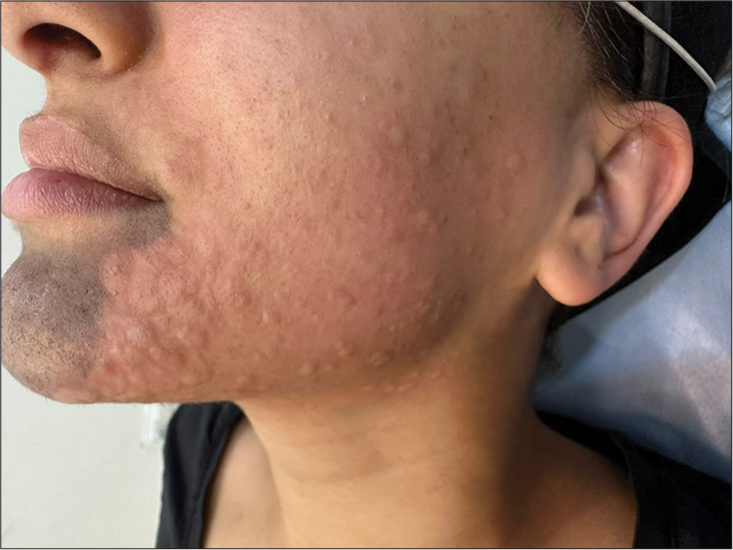Translate this page into:
Inducible urticaria or skin lesions induced by Nd: YAG laser?
*Corresponding author: Nidhi Raghunandan Sharma, Skin Health Clinic, Gurgaon, Haryana, India. drnidhirsharma@gmail.com
-
Received: ,
Accepted: ,
How to cite this article: Sharma NR, Patil A, Marwah M, Sadoughifar R. Inducible urticaria or skin lesions induced by Nd: YAG laser? Indian J Skin Allergy. 2025;4:85-6. doi: 10.25259/IJSA_41_2023
Dear Editor,
Laser treatment is common in dermatology practice. Overall, laser therapy is well tolerated by most of the patients. Transient wheal and flare reactions after laser treatment are common.[1] The pathogenic mechanism of development of transient wheal and flare is suggested to be neurogenic origin and not due to traditionally known histamine or mast cell-based mechanism.[1] A case of immediate hypersensitivity after Neodymium-doped Yttrium Aluminum Garnet (Nd:YAG) laser treatment for a tattoo removal has been reported.[2] In that case, prior treatment with corticosteroid and antihistamines prevented such reactions with further laser treatments. An antigen from the ruptured hair follicle due to heat from laser may cause delayed hypersensitivity reaction in few susceptible patients.[3] However, true urticaria after laser treatment is uncommon,[4] and on literature scan, we could not find any reported cases of inducible urticaria after Q-switched Nd:YAG laser. We report skin lesions of inducible urticaria following Q-switched Nd:YAG laser in an adult female.
A 36-year-old female presented with skin pigmentation mainly facial tanning and few freckles over her face since past few months. As the patient wished to have fast acting treatment for current skin problem, Q-switched Nd:YAG laser procedure was advised and she was prescribed concomitant sunscreen and Vitamin C-based serum. She reported history of physical urticaria suggestive of dermographism and reacted to any kind of trauma or scratch. During such episodes, she used to take tablet fexofenadine 180 mg as and when required for relieving excessive itching. However, she had no complaints with any previous skin procedures including laser treatment. Laser toning was planned for her (Spot Size – 8 mm, Energy – 1.2 J, Frequency – 7 Hz) along with carbon application. Laser toning was performed after application of thin layer of carbon. Within few minutes of the procedure, the patient developed small, red, raised, itchy wheals over her treated area. There were mild perifollicular edematous lesions [Figure 1]. The rashes subsided within 60 min of the procedure. Clinical diagnosis of physical urticaria was made based on the history and clinical appearance of lesions. She was treated with local application of lactocalamine lotion, tablet bilastine 20 mg daily along with general counseling about the disease with adequate control.

- Urticaria lesions after Q switch laser.
Laser treatment is well tolerated by most patients without much concerns of serious adverse reactions. Minor and transient skin-related adverse events are possible after laser treatment. These adverse events are manageable in most of the patients. Literature search revealed reported cases of development of severe urticaria after laser treatment for hair reduction[5] and urticarial vasculitis induced by diode laser photo-epilation.[6] Cryogen spray cooling used along with laser skin surgery can also induce acute erythema and urticaria.[7] Panth et al. have reported dermographic urticaria induced by long-pulsed diode laser.[4] The patient reported by Panth et al. had history of chronic urticaria for 1 year before this episode and no episodes of dermographism or history of physical urticaria were reported.[4] In our patient, there was a history of dermographism, but not with laser treatment. Our patient did not have exposure or history of treatment with Q-switched Nd:YAG laser in the past. After few minutes of the procedure, the patient developed dermographic urticaria which subsided within half an hour of procedure. According to best of our knowledge, this is probably the first case of inducible urticaria following Q-switched Nd:YAG laser. The Q-switched Nd:YAG laser may have acted as a trigger for inducible urticaria resulting in mast cell degranulation in the local area of application. We could not do a re-challenge test with laser test patch on another site to confirm the cause.
The differential diagnoses would include post cryogen spray cooling or post laser raised skin lesions that are more commonly observed immediately after the procedure. However, the lesion in our patient was clinically suggestive of dermographic urticaria. The present patient had history of dermatographism and laser therapy may have acted as a trigger for inducible urticaria. Therefore, this case highlights that dermatologists should take detailed history of physical urticaria before using laser therapy and should be well prepared to manage skin lesions following Q-switched Nd:YAG laser.
Ethical approval
The Institutional Review Board approval is not required.
Declaration of patient consent
The authors certify that they have obtained all appropriate patient consent.
Conflicts of interest
There are no conflicts of interest.
Use of artificial intelligence (AI)-assisted technology for manuscript preparation
The authors confirm that there was no use of artificial intelligence (AI)-assisted technology for assisting in the writing or editing of the manuscript and no images were manipulated using AI.
Financial support and sponsorship: Nil.
References
- Laser-induced weal and flare reactions: Clinical aspects and pharmacological modulation. Br J Dermatol. 2002;146:863-8.
- [CrossRef] [PubMed] [Google Scholar]
- Immediate cutaneous hypersensitivity after treatment of tattoo with Nd:YAG laser: A case report and review of the literature. Ann Allergy Asthma Immunol. 2002;89:215-7.
- [CrossRef] [PubMed] [Google Scholar]
- Urticaria induced by laser epilation: A clinical and histopathological study with extended follow-up in 36 patients. Lasers Surg Med. 2012;44:384-9.
- [CrossRef] [PubMed] [Google Scholar]
- Dermographic urticaria induced by long-pulsed diode laser-assisted epilation: Rare etiology of a common eruption. Indian Dermatol Online J. 2017;8:136-7.
- [CrossRef] [PubMed] [Google Scholar]
- Severe urticaria after laser treatment for hair reduction. Dermatol Surg. 2010;36:147-51.
- [CrossRef] [PubMed] [Google Scholar]
- Urticaria vasculitis induced by diode laser photo-epilation. Dermatol Surg. 2000;26:1082-3.
- [CrossRef] [PubMed] [Google Scholar]
- Cutaneous effects of cryogen spray cooling on in vivo human skin. Dermatol Surg. 2006;32:1007-12.
- [CrossRef] [PubMed] [Google Scholar]





